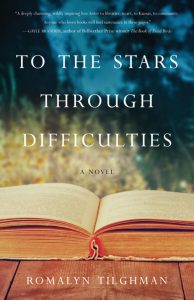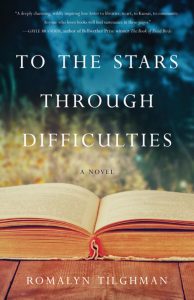Featured author: Romalyn Tilghman
 Romalyn Tilghman’s first novel To the Stars Through Difficulties has been described as a "love letter to libraries." So of course, I had to read it!
Romalyn Tilghman’s first novel To the Stars Through Difficulties has been described as a "love letter to libraries." So of course, I had to read it!In To the Stars Through Difficulties, three women from different parts of the country come together in modern day New Hope, Kansas. Traci is a New York artist, hired to teach classes at the struggling arts center. Angelina is a PhD student researching Carnegie libraries in the town that her grandmother called home. Gayle’s hometown has just been decimated by a tornado, so she’s drawn to New Hope for an opportunity to sew and craft with a group while she deals with her grief. As the three women tackle art projects to raise funds for the arts center, share their stories and unravel the mysteries of the past, they all discover their true strength and direction. This compelling story of friendship and empowerment is enriched by a solid foundation in the history of Kansas and Carnegie libraries. Tilghman’s work was inspired by research into Carnegie libraries built in the early 1900s and local arts agencies formed later in the century. She notes that strong women played a big role in bringing arts to the plains.
“Many Kansas women came from the East and cities where cultural opportunities were more prevalent,” Tilghman said. “Women missed their books and operas, and, equally important, they were bound and determined to provide more opportunities for their children. Books provided escape from dust and drudgery and provided a glimpse of the outside world.”
If you’re like me, you see a lot of potential for a book group discussion in Tilghman’s first novel. We’ve got you covered. Reserve the Book Group in a Bag Kit to check out 10 titles and a discussion guide for your group.
Check out Tilghman's recommended reads below and then read on for an interview with the author.
View complete listAn Interview with Romalyn Tilghman
Your novel has been described as “a love letter to libraries.” How do you believe modern public libraries impact the lives of the people they serve?
Why were women the driving force behind the founding of public libraries in Kansas?
I love that the core truths of The Wizard of Oz, by L. Frank Baum, influenced your novel. Are there other works of fiction that influenced or inspired you?
It’s hard to make a short list of other novels that inspired me. If I had to pick one, it would be To Kill a Mockingbird for its look at a small town and moral decisions.
In a previous interview you explained why you chose to write fiction based on your research, rather than nonfiction. Are you at all tempted to follow your first novel up with a work of fact?The only nonfiction I might consider would be a series of short essays about things I’m learning as I visit libraries on my book tour. As much as I’d love to delve deeper into library history, I don’t think I have the time or perseverance to do a comprehensive study. There are at least a couple that have been done well. Carl Bobinski’s book, Carnegie’s Libraries, published by the American Library Association is seminal and Allen Gardiner’s Carnegie Legacy in Kansas is a lot of fun as well as informative. Both were invaluable to me in writing my novel.
What was the greatest challenge in turning years of notes into a work of fiction?
As a first time author, what challenges have you faced in publishing and marketing your book? What have you enjoyed the most about the publishing and marketing journey?
Give us some recommendations, please! Who are some of your favorite authors? Do you have additional recommendations for readers interested in learning more about Carnegie libraries and women in the arts and humanities?
It might not surprise you to hear I love books about books: 84 Charing Cross Road, The Readers of Broken Wheel Recommend, The Guernsey Literary and Potato Peel Pie Society, The Book That Matters Most.
Coming in January is a new novel, Carnegie’s Maid, by Marie Benedict, who wrote The Other Einstein. It will be a great companion piece to mine, since it documents the role of Clara Kelley, the Irish maid who worked in the Carnegie household. She is credited with inspiring Andrew Carnegie’s philanthropy. I was able to land a galley at Book Expo and have fingers crossed some of Benedict’s many readers will find my book as well!
About the Author
Straight out of graduate school, native Kansan Romalyn Tilghman was hired as executive director of the Association of Community Arts Councils of Kansas and was lucky enough to work with rural arts councils throughout the state. She saw first-hand how groups of (mostly) women encouraged culture on the Plains. From there, she went on to work for the National Endowment for the Arts as a regional representative, eventually serving a territory that stretched over the Dateline, over the Equator and over the Arctic Circle. For more than twenty years, she has worked as a freelance consultant in the arts – conducting strategic planning, initiating audience engagement projects, and assessing grant programs for nonprofit organizations, government agencies and private foundations. She has served on the boards of Americans for the Arts, Association of California Symphony Orchestras and Western Arts Alliance as well as on numerous national panels. She lives in Long Beach, California. To the Stars through Difficulties is her first novel.











